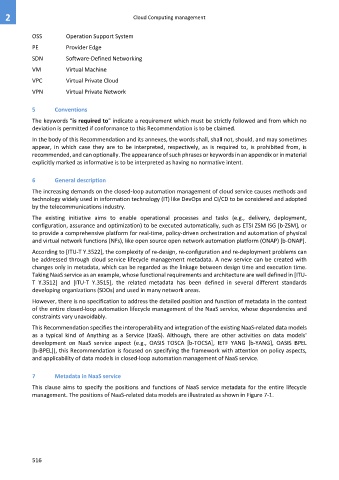Page 524 - Cloud computing: From paradigm to operation
P. 524
2 Cloud Computing management
OSS Operation Support System
PE Provider Edge
SDN Software-Defined Networking
VM Virtual Machine
VPC Virtual Private Cloud
VPN Virtual Private Network
5 Conventions
The keywords "is required to" indicate a requirement which must be strictly followed and from which no
deviation is permitted if conformance to this Recommendation is to be claimed.
In the body of this Recommendation and its annexes, the words shall, shall not, should, and may sometimes
appear, in which case they are to be interpreted, respectively, as is required to, is prohibited from, is
recommended, and can optionally. The appearance of such phrases or keywords in an appendix or in material
explicitly marked as informative is to be interpreted as having no normative intent.
6 General description
The increasing demands on the closed-loop automation management of cloud service causes methods and
technology widely used in information technology (IT) like DevOps and CI/CD to be considered and adopted
by the telecommunications industry.
The existing initiative aims to enable operational processes and tasks (e.g., delivery, deployment,
configuration, assurance and optimization) to be executed automatically, such as ETSI ZSM ISG [b-ZSM], or
to provide a comprehensive platform for real-time, policy-driven orchestration and automation of physical
and virtual network functions (NFs), like open source open network automation platform (ONAP) [b-ONAP].
According to [ITU-T Y.3522], the complexity of re-design, re-configuration and re-deployment problems can
be addressed through cloud service lifecycle management metadata. A new service can be created with
changes only in metadata, which can be regarded as the linkage between design time and execution time.
Taking NaaS service as an example, whose functional requirements and architecture are well defined in [ITU-
T Y.3512] and [ITU-T Y.3515], the related metadata has been defined in several different standards
developing organizations (SDOs) and used in many network areas.
However, there is no specification to address the detailed position and function of metadata in the context
of the entire closed-loop automation lifecycle management of the NaaS service, whose dependencies and
constraints vary unavoidably.
This Recommendation specifies the interoperability and integration of the existing NaaS-related data models
as a typical kind of Anything as a Service (XaaS). Although, there are other activities on data models'
development on NaaS service aspect (e.g., OASIS TOSCA [b-TOCSA], IETF YANG [b-YANG], OASIS BPEL
[b-BPEL]), this Recommendation is focused on specifying the framework with attention on policy aspects,
and applicability of data models in closed-loop automation management of NaaS service.
7 Metadata in NaaS service
This clause aims to specify the positions and functions of NaaS service metadata for the entire lifecycle
management. The positions of NaaS-related data models are illustrated as shown in Figure 7-1.
516

